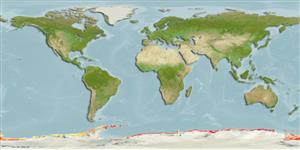>
Perciformes/Notothenioidei (Icefishes) >
Bathydraconidae (Antarctic dragonfishes) > Bathydraconinae
Etymology: Vomeridens: Latin, vomer = ploughshare; in fishes = bone forming the front part of the roof of the mouth (1823) + latin, dens = teeth (Ref. 45335).
Environment: milieu / climate zone / depth range / distribution range
Ecologia
marino batidemersale; distribuzione batimetrica 500 - 813 m. Deep-water; 60°S - 78°S
Southern Ocean: Weddell and Ross seas, South Orkney Islands and Antarctic Peninsula.
Size / Peso / Age
Maturity: Lm ? range ? - ? cm
Max length : 22.0 cm SL maschio/sesso non determinato; (Ref. 5192)
Biology unknown.
Life cycle and mating behavior
Maturità | Riproduzione | Deposizione | Uova | Fecundity | Larve
Gon, O., 1990. Bathydraconidae. p. 364-380. In O. Gon and P.C. Heemstra (eds.) Fishes of the Southern Ocean. J.L.B. Smith Institute of Ichthyology, Grahamstown, South Africa. 462 p. (Ref. 5192)
IUCN Red List Status (Ref. 130435: Version 2024-1)
Threat to humans
Harmless
Human uses
Pesca: di nessun interesse
Strumenti
Special reports
Download XML
Fonti Internet
Estimates based on models
Preferred temperature (Ref.
123201): -1.8 - 1.3, mean 0.3 °C (based on 361 cells).
Phylogenetic diversity index (Ref.
82804): PD
50 = 1.0000 [Uniqueness, from 0.5 = low to 2.0 = high].
Bayesian length-weight: a=0.00229 (0.00120 - 0.00437), b=3.24 (3.07 - 3.41), in cm total length, based on LWR estimates for this (Sub)family-body shape (Ref.
93245).
Trophic level (Ref.
69278): 3.6 ±0.4 se; based on size and trophs of closest relatives
Resilienza (Ref.
120179): Medio, tempo minimo di raddoppiamento della popolazione 1.4 - 4.4 anni (Preliminary K or Fecundity.).
Fishing Vulnerability (Ref.
59153): Low vulnerability (17 of 100).
